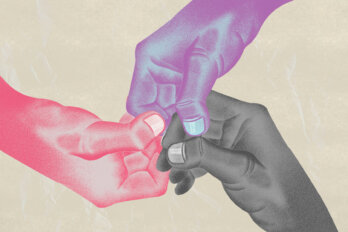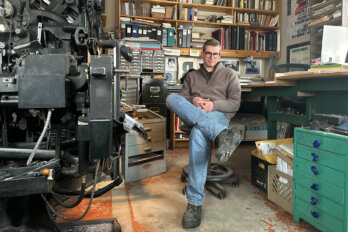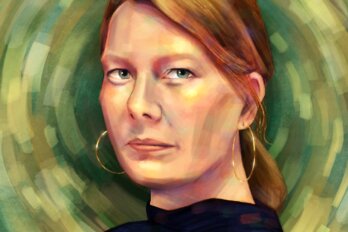A few years ago, my family and I lived at an international school in a cliffside Italian village overlooking the Adriatic. My husband was teaching, and I was writing. I was also in charge of ushering our two shell-shocked kids to and from their village schools, trying to put a positive spin on the fact that they spoke zero Italian as I backed away from the gate: “They will give you mozzarella di bufala at lunch! Ciao!”
Faculty at Julian’s school came from around the world—a mini-UN of teachers. Right away, I noticed something different about them. When I made get-to-know-you small talk, they didn’t immediately turn to their professional lives; there was no CV rundown in response to the question “What do you do?” Instead, they talked about what they actually did, as in, during the time they weren’t working. It turned out that the Scottish science teacher also competed in decathlons, and the Dutch economics prof was always appearing in shiny bicycling clothes and helmet, heading off to the mountains. By Friday at 5:00 p.m., other residents of our village were card sharks, sketchers, gardeners, and hikers. Consequently, I was asked more than once, in a range of fetching European accents, “So, what is your hobby?”
Good question, and one I had literally never been asked in Toronto. What had I been doing all these years? Ingesting social media and occasionally hitting museums were not sustained passions; they were fleeting diversions. Did the odd yoga class count? How about trading sassy pop culture barbs over wine with friends? Good times, but also not a hobby.
A hobby is an interest practiced for pleasure, rather than reward, and in a work-centric culture, it’s no surprise that the concept has faded from the vernacular. The Puritans warned of the “descent into idleness,” and Victorian-era women’s magazines instructed women that crafting and musical pursuits must be “useful.” We may not say it out loud, but the idea of just following pleasure week after week, fervently, feels a little . . . lazy. Are we any different from those prissy Puritans?
Perhaps not coincidentally, the old-fashioned hobbies of the crafting and gathering type—model railroad making; mineral collecting—appear to be in decline. One British paper reports a survey showing that one in four Brits describes “watching TV” as his or her favorite hobby; Americans spend thirty-three hours per week doing the same. The British survey showed that practicing a musical instrument was a pastime for only 4 percent, while fishing was enjoyed by only 2 percent. Local papers periodically revisit the mournful feature that reads like an obituary when yet another beloved hobby store closes down. Of course, fetishists who can’t afford bricks and mortar set up online, and some niche hobbies thrive on the Internet (at bagophily.com, one can commune with other collectors of airline barf bags).
But our nostalgia for the craft store is not just for homeless model ship kits, but also for the free time they once inhabited. RIP, weekends. It’s no coincidence that hobbies boomed in popularity in the United States in the 1930s when the eight-hour workday was finally legislated, and more people than ever before had weekends off.
Hobbies exist in a gray area of our free time; they’re supposed to be the opposite of work, but they can be laborious. Steven M. Gelber, a history professor at Santa Clara University, has written that hobbies “take work, turn it into leisure; take leisure, turn it into work.” By definition, hobbies are freely chosen, but Gelber argues that many of them are repetitive and goal-oriented, imitations of work that we invite into our home (thus reinforcing capitalist values and keeping us cheerful cogs in the machine, he notes). Hobbies can also feel inherently conservative, cementing gender roles. Gelber writes how 1950s women were encouraged to sew and make music, while men were supposed to flex their DIY muscles in the garage with very big tools, or exercise their man-science brains with model kits.
But even if some hobbies follow the contours of work, there’s one significant, liberating difference: nobody cares how good you are at your hobby but you. In amped-up, high-stakes, economically anxious times, hobbies are a deliciously low-stakes pursuit. Yes, there may be spectatorship and competitiveness within the insular world of a particular hobby (in Utah a few years ago, a Dungeons & Dragons hobbyist, displeased with his friend’s behavior as Dungeon Master, snuck into the Master’s house and beat him with a hammer). But most hobbies are personal refuges, a private space in the week where we can explore mastery for its own sake.
My husband’s parents have become bird-watchers in their later years. At first, I admit, I didn’t totally get it. Bird-watching is a type of collecting, really, with its checklists and insider lingo. It’s also one of the fastest-growing hobbies in North America. They wear funny hats and keep binoculars with them at all times; it is, like so many hobbies, supremely uncool. But the pleasure bird-watching brings my in-laws is palpable. It transforms their holidays, shaping their weekends and changing the meaning of the landscape that they’re in.
It’s also something that bonds them as a couple. When I picture them, I see them side by side on the edge of a road, necks craned, binoculars tilted to the heavens. My father-in-law, Brian, describes it as “a pair of matched minds pursuing the same end.” But he also likes the solitude of bird-watching alone. He speaks of the mental exercise: the patience required on the long wait for the bird that may or may not emerge; the rise to the surface of all his senses. He has what positive psychologist Mihaly Csikszentmihalyi calls an “autotelic personality,” someone with an innate curiosity to master things just for their own sake and the ability to concentrate on those things for long periods of time (collectors and catalogue hobbyists). Brian admits to having taken over 75,000 photos (he whittled one trip to Mexico from 10,000 photos to 10). “Birds have this power, this spiritual power, to bring us to ourselves, to tame our distracted mind. Their appearance can feel like grace, and their disappearance contributes to the magic,” he says.
Hobbies are also incredibly good for you physiologically. Hobbies can boost social interaction, which reduces stress—and loneliness. They may even make you less susceptible to dementia. Researchers at the Mayo Clinic interviewed 256 seniors about their leisure habits. At the start of the survey, none of the group—average age eighty-seven—displayed any impairment of memory or thought. Approximately four years later, 121 of the subjects had developed mild cognitive issues. Researchers discovered that certain activities indicated a lower likelihood of impairment, such as socializing and using the computer for surfing and games. But by far, the best way to stave off mental decline was to participate in artistic hobbies. Subjects who had regularly taken part in artistic endeavours in middle or old age—like painting, sculpting, or drawing—were 73 percent less likely to develop mild cognitive impairment than those who hadn’t.
Crafters (pottery, woodworking, quilting, sewing) were 45 percent less likely to develop memory issues. And if you really need to think of everything in terms of work, hobbies breed professional success, too: Nobel prize-winners are more likely than other scientists or members of the public to have had long-standing hobbies. A recent study found that those who practiced creative hobbies in their free time were better equipped to recover from the demands of work after hours, more likely to help others, and more likely to be creative when they returned to the office.
All of this productivity stuff is well and good, but a hobby’s real value is in its purposelessness. In 1932, Bertrand Russell wrote that “play” had been crippled “by the cult of efficiency.” The idea that every activity must be useful takes on a new cast in the Internet age: the web can make an entrepreneur out of anyone with a mouse. There’s a lure to monetize what we become good at, to turn the amateur into the professional. Uber started as a hobby! Maybe my idea will grab the world by storm! This is what’s been called a “jobby,” not a “hobby”: a pursuit with an agenda. But hobby as side-hustle kind of misses the point: a hobby is something that’s not about winning, it’s about doing one thing deeply.
So often, the self feels inescapable; privately, we cultivate our self online all day, posting versions on social media; professionally, many of us work at jobs with an online dimension, broadcasting every beat of our day. Here’s what we need in a weekend: flow. Csikszentmihalyi describes the “flow state” as total immersion in an activity for its own sake (this is why paid work doesn’t count, though flow at work is an incredible experience). It’s the feeling of being out of self, and out of time: “Every action, movement, and thought follows inevitably from the previous one, like playing jazz. Your whole being is involved, and you’re using your skills to the utmost.”
In 1776, while riding in a coach from Henley to Birmingham, James Boswell sought Samuel Johnson’s advice about a creeping feeling of melancholia. Dr. Johnson had an answer for him: “When you have a place in the country, lay out twenty pounds a year upon a laboratory. It will be an amusement to you . . . Take a course of chemistry or a course of rope-dancing, or a course of anything to which you are inclined at the time. Contrive to have as many retreats for your mind as you can, as many things to which it can fly from itself.”
So, Johnson was advising Boswell that the best way to manage his depression was to get a hobby (even though “rope-dancing” means tightrope walking, which sounds a little sarcastic). “Retreats for your mind”—don’t we all need those, and isn’t that just flow? Hobbies are the way of unalloyed pleasure, which we so desperately need after those long hours and nights, tethered to our devices and our jobs. The tasks that make up the responsibilities of our lives have end points, but the hobby is boundless. It can be a site of rejuvenation, and preparation for epiphanies to come.
On Saturday morning at 10:00 in Tucson, Arizona, an adult colouring club meets. They bring their own books and colored pencils and sit down at a long table in a quiet room. Jamar runs the group, booking the space, posting the location (library, community center, retirement home) online on meetup.com; he walks around the room quietly, murmuring encouragement as everyone colours.
A few winters ago, Jamar was living in Montana, bored and housebound by snow, and he began drawing mandalas. Then he started mirroring them, creating elaborate Escher-esque patterns, complex line drawings that begged to be colored. This was before the adult colouring book trend took off, as it has: roughly 12 million adult coloring books were sold in 2015, up about 1 million from 2014. Jamar decided to self-publish and sell his drawings online. Then he read that people were gathering and colouring together, and he decided to start a group. “I realized pretty quickly that it’s not about the colouring, it’s about bringing people together.”
It’s odd, really: a group of adults with their heads bowed, silently coloring. Sometimes there’s small talk and laughter, and once, someone was being “disrespectful” and Jamar had to ask him to leave. It’s easy to sniff at this trend, which has the faddish feel of Cabbage Patch Kids and Tae Bo. Adults colouring, grumble the grumblers, is a form of mass infantilization, and the packaging of mindfulness for profit. It’s not even creative! Sheeple, put down the crayons!
But this tut-tutting means nothing in the room at the Tucson coloring club. Different people come every week, and friendships have been forged. Those who love it describe a mental shift that feels entirely different from other kinds of weekend hobbies. “It’s the neatest experience, your mind goes into a place where it hasn’t been. It’s like it’s structured and it’s free,” says Robin, who works in medical publishing. She lived in New York and St. Louis before moving to Arizona and relishes the quiet of the desert. She never really had a hobby before. Painting and pottery classes didn’t yield much pleasure. She and her husband know Jamar from their regular nights at the restaurant where he waits tables, and at his invitation, she decided to come out one Saturday. She was apprehensive, but she enjoyed the ritual of preparation: the fresh pack of pencils and the crisp new book, like a kid on the first day of school. And once she sat down and started colouring, she was engrossed.
The rhythmic repetition sounds exactly like flow: the loss of time, the world falling away. The positive effects of colouring are well documented. In one study, the anxiety levels of subjects were measured in a baseline test. Then, researchers described a scary experience, increasing participants’ anxiety. In that heightened state, they were randomly assigned to colour a blank page or a patterned page. The blank page people showed no decrease in anxiety levels, but those who coloured were significantly less anxious.
“It gets you out of a very busy, frantic pace,” says Robin. “It’s like your circuits slow down. When you were a kid, you could sit in the corner and play with dolls or cars or colouring books; you did it for hours and that was all that existed in the world. This is like that. I’ve never felt that as an adult.”
Sometimes a hobby can save a life.
Tyler is a young software developer in Portland, Oregon. He got into origami on a road trip with his family when his mother gave him the Klutz guide to origami. Soon, he was folding constantly, leaving his creations around town. When he went into restaurants, he would leave pieces behind; in one Thai restaurant, his objects accrued at the counter until they formed a pile. The manager asked him to make a koi fish out of a hundred-dollar bill, based on an Internet sensation, “Wan Park’s dollar koi,” where the hands of an origamist take a dollar bill and fold it into a beautiful scaled fish with whiskers and eyes in the exact right place. The patterns didn’t quite line up on the hundred, but Tyler did finish, staying several hours after closing.
On weekends, he often does origami at home, alone, but on the second Sunday of each month, he attends a group at a Portland library. He’s not the most social person, so this can be a struggle for him, but he makes a conscious point of going. The group that gathers isn’t uniform, with people from ages eight to sixty-ish. It’s equal parts male and female, culturally diverse, with many older Japanese people. There’s no instruction. Tyler wants to see what other people are making and get inspired, and also (he admits) show off his own work, which is spectacular: long braids that look sculpted out of marble; a row of delicate birds linked at the wings, facing different directions, as if breaking out of one continuous piece of paper.
Even as it shares some of the qualities of his paid work—the logic and patterning of software—origami is an escape from what he does during the week. “Software is endless, and each piece of origami has a beginning and an end,” he says. It isn’t, he notes, meditative: it can actually be a bit of an adrenaline rush, as he pushes to the finish.
A few years ago, Tyler suffered serious depression, and found that one way to get out of it was to use his hands. Repetitive motions release serotonin, and origami felt like a way to manage the pain. He’s doing better now, but he worries about the depression returning; he works to keep it at bay. In a poignant email, he described how important this hobby is to his life. It provides a sense of purpose, and at the Saturday club, it puts him inside a larger community.” My worldview shifted from being in so much pain for so long. I’m terrified that something will happen again and I’ll be trapped in this body suffering for years,” he wrote. “For whatever reason I seem wired to find at least some meaning in sharing the things I find meaningful with other people. Sharing origami designs and helping someone learn to fold is a good way to do that.”
Excerpted from: The Weekend Effect by Katrina Onstad © 2017. Published by HarperCollins Publishers. All rights reserved.





